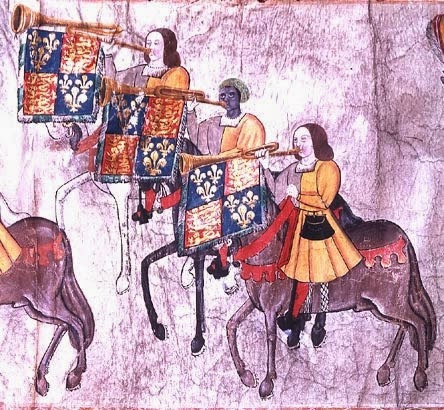The British freelance journalist and historian Miranda Kaufmann (www.mirandakaufmann.com) has provided me a starting lead from the following bibliographic source, ‘Courts, Blacks at Early Modern European Aristocratic’, Encyclopaedia of Blacks in European History and Culture (2008),Vol. I, pp. 163-166 (edited by Eric Martone):
Europeans had employed black musicians and entertainers at court since at least 1194, when Holy Roman Emperor Henry VI (1165-1197) was accompanied by turbaned black trumpeters on his triumphal entry into Sicily. In 1470 a “black slave called Martino” was purchased to be the trumpeter on board the Neopolitan royal ship Barcha. Henry VII of England employed a black trumpeter named John Blanke, who was paid 8d a day in 1507. Henry VIII retained Blanke’s services. The Westminster Tournament Roll of 1511, which commemorates the celebrations that marked the birth of a short-lived son to Henry VIII and Katharine of Aragon, depicts a black trumpeter believed to be Blanke.
Elizabeth I had a “Lytle black a more” boy at her court and Anthonie Vause, a black trumpeter, was employed at the Tower of London in 1618. A Moorish “taubronar” or drummer devised a dance with 12 performers in black and white costumes for the Shrove Tuesday celebrations at the court of James IV of Scotland (1473-1513) in 1505. Teodosio I, Duke of Bragança (1510-1563) had ten black musicians, who played the charamela (a wind-instrument). A 1555 list of galley slaves belonging to Cosimo I de’ Medici (1519-1574) of Florence included a moro negro described as a trumpeter. In 1713, Frederick William I, later king of Prussia, asked for “several black boys aged between 13 and 15, all well-shaped” to be trained as musicians for his military regiments.
In my own Google image searching, I came across this shared sketch of royal musicians in Portugal (c.1522)…
Of course they are wind and brass players, but instrument specifications notwithstanding they ARE of dark skin, and their matching hats and uniforms suggest they play (and work) for a common employer.
The royal trumpeter, John Blanke, was known to have been the court musician of King Henry VII and Henry VIII of England. The Oxford Dictionary of Biography provides this about him:
His surname may have originated as a nickname, derived from the word blanc in French or blanco in Spanish, both meaning ‘white’. Blanke was part of a wider trend for European rulers to employ African musicians, dating from at least 1194, when turbaned black trumpeters heralded the entry of the Holy Roman emperor Henry VI into Palermo in Sicily. It has been suggested that Blanke arrived in England with Katherine of Aragon when she came to marry Arthur, prince of Wales, in 1501. Between 1507 and 1512 Blanke was one of eight royal trumpeters under the leadership of Peter de Casa Nova. The first payment to ‘John Blanke, the blacke Trumpet’ was made in early December 1507, when he was paid 20s. (8d. a day), first by Henry VII and then from 1509 by Henry VIII. The images extracted from the 60ft-long Westminster Tournament Roll, shows six trumpeters, one of whom is Black and is almost certainly John Blanke. All the trumpeters are wearing yellow and grey, with blue purses at their waists. John Blanke is the only one wearing a brown turban latticed with yellow. He is mounted on a grey horse with a black harness.
While I have yet to locate stringed instruments represented in preserved royal tapestries, it is encouraging to learn of the presence and activities of persons having dark-skinned (presumably African or Arabic) ancestry working as musicians.
The French mulatto swordsman, violinist and composer Joseph Boulogne, le Chevalier des Saint-Georges (1745-1799) is often misnamed Le Mozart noir because of his precocious accomplishments, which occurred in the fencing school first, then in the musical salon. By the time Saint-Georges was establishing himself as the finest swordsman in Paris, Mozart, eleven years his junior--was already "on the road" as a Wunderkind with Papa Mozart and sister Nannerl in search of an ever-elusive better court appointment than that of Archbishop Colloredo in Salzburg. At the same time that Saint-Georges and Mozart were making their respectively challenged ways around class and caste-conscious Paris (and more of Europe for Mozart), Ignatius Sancho (c.1729-1780) was apparently doing the same in London. Less is known of his musical compositions than those of Saint-Georges, but both men served as unique eyewitnesses to British and French sociopolitical developments. Sancho witnessed and wrote about the Gordon Riots of 1780, which were largely religious and politically charged. Saint-Georges nearly lost his head (literally!!) when he was arrested and imprisoned (and awaiting execution) at the height of the Reign of Terror during the French Revolution.
Lest we fear that this blog will only deal with Euro-African isolated music history, please know that Barzillai Lew served in the Continental Army in Massachusetts during the American Revolution as a fifer (the instrumental equivalent of the piccolo). In his book celebrating the Harlem Renaissance, Kareem-Abdul Jabbar makes mention of Harry Lew, who played pre-NBA basketball with the Harlem Rens in the 1930s, who was of the same family…'music and basketball were to be found in the same family tree!!
I wrote a paper, "Mishaps, Misnomers and Misconnected History: Ludwig van Beethoven, George Bridgetower and Rodolphe Kreutzer"...and read it (!!) for a Black History Month lecture six years ago. Instead of repeating information discovered about George Augustus Polegreen Bridgetower (1778/1780-1860), I'll just dedicate the next blog post to that paper. It's worthwhile to read…'once the football games get too predictable!!
Peace…"CQN"


No comments:
Post a Comment